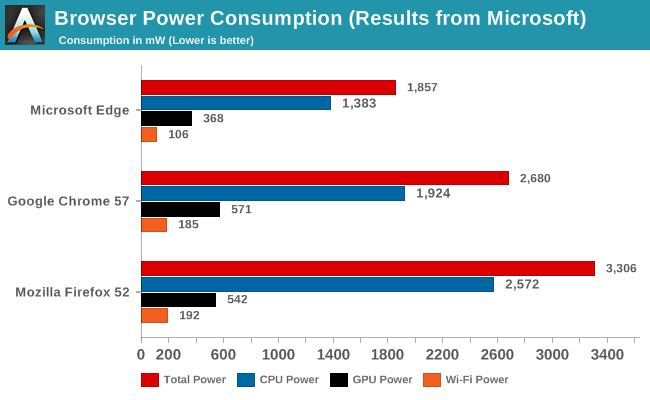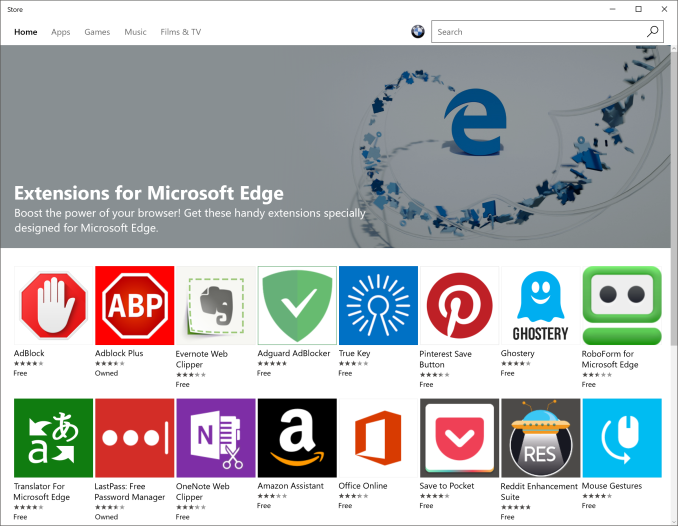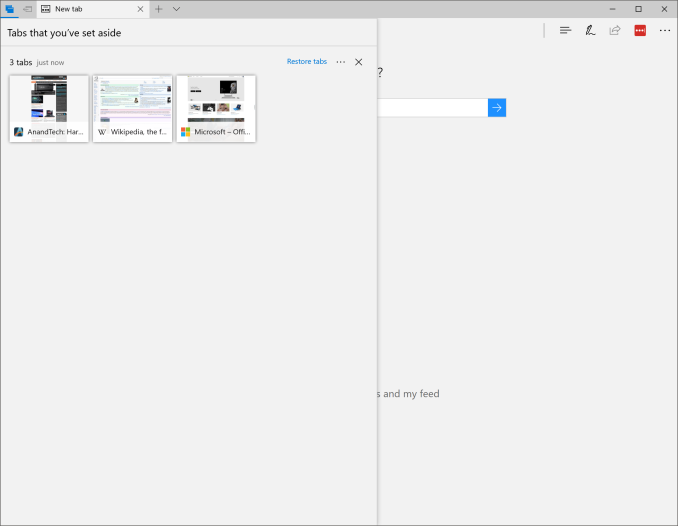The Windows 10 Creators Update Arrives
by Brett Howse on April 25, 2017 8:00 AM EST- Posted in
- Software
- Operating Systems
- Windows
- Microsoft
- Windows 10
Edge Improvements
When Edge launched, Microsoft seemed to have a couple of goals. First, they would dramatically improve security over Internet Explorer, and second, they would drastically improve performance, and keep up the performance improvements over time.
Edge adoption has been very low though. When it first launched, it was lacking a lot of basic features, with important additions like extension support only coming with the Anniversary Update. Extensions was a arguably the biggest single feature missing, and it has been very nice to have a much more capable browser because of this addition, but with low usage share of Edge, coupled with extensions having to be added to the Windows store by the developer, has resulted in there still only being a handful of extensions in the store. At my count, there are 27 extensions, but that might vary based on region. It’s a step in the right direction, and this one change has made Edge much more useful than before.
Edge excels in some areas. Its support for high resolution displays, and its text rendering, continues to be one of its biggest strengths. Performance on scripting is generally quite solid, although it still struggles with pages like Twitter if they are left open for a long time. Microsoft has posted quite a few blog posts about how they have optimized things like scrolling performance with touch, mouse, or keyboards, as well as battery life improvements. Edge has come a long way, and they continue to improve it with every release.
Edge didn’t get anything as big as extensions with this update, but it still got quite a few improvements. The most noticeable is the ability to expand tabs to show the entire page in a mini-window at the top of the screen. This is very similar to how Internet Explorer worked in its touch mode in Windows 8, and can be a useful feature if you are one of those people who keep losing tabs. Also, you can “set tabs aside” which lets you collapse open tabs to the left, where there’s a box to let you open them again. It’s an interesting idea, but in practice it seems to need quite a bit of work. You can’t put individual tabs aside – it’s all or nothing – instantly making it less useful. Also, if you restore a tab from one you’ve put away, and then you close that tab, it’s gone. There’s no way to keep a set of tabs set aside permanently which would be a nice take on favorites. Once tabs are put aside, you can add them to favorites, or share them. The share idea is quite nice, and makes it very simple to share multiple sites with someone in one email. Still, it would be nice to see this fleshed out a bit more.
Microsoft has been touting Edge’s battery life performance for some time now, and they continue to improve Edge to make it more efficient. Their testing methodology is all open-source, which certainly helps with its credibility. According to Microsoft’s measurements, during their tests on identical Surface Book laptops, and averaged over sixteen iterations per browser, Edge used 31% less power than Chrome 57, and 44% less power than Firefox 52. These are significant amounts, and in a power basis, Edge is using under 2 Watts for the same activity that Chrome is using over 2.5 Watts, and Firefox is using around 3.25 Watts. Battery capacity is always going to a be a limit on notebooks, so any efficiency gains are important.

Edge has also gained support for ePub digital books, and WebRTC 1.0 is now on out of the box. There are other small changes like being able to run an .exe file directly rather than having to save it first, and there are some small improvements to PDFs in Edge, and Web Notes.
Also, in the never-ending struggle to remove Flash from the web, Microsoft has made the decision to make Flash click to run in Edge. That means that any page that wants to run Flash won’t be able to, but you can click an icon to enable it. It’s not very obvious, with the icon resembling a puzzle piece, but there is a graphic which shows you what to do the first time it pops up. The results of this change have been mixed, but with browsers moving to disable Flash by default, hopefully that will pressure sites away from using it.
 This puzzle icon means Flash can be enabled for the page
This puzzle icon means Flash can be enabled for the page
Overall, Edge has made some improvements, but nothing huge like in the last update. It needs some more basic functionality added though, such as the ability to view a page source (the debugger tools are overly complex for simple tasks) and it is still far easier to do a lot of tasks in Chrome, which shouldn’t be the case this far into Edge’s existence.












69 Comments
View All Comments
EricaSplash - Friday, April 28, 2017 - link
when will they learn that one friggin place for settings is a lot better than two? Just go back to the old control panel for F's sakemartixy - Friday, April 28, 2017 - link
WSL is good stuff. So Woot.TheUsual - Saturday, April 29, 2017 - link
I'd definitely like to disable updates/restarts while the computer is hibernated.ricster7227@gmail.com - Saturday, April 29, 2017 - link
I have had a number of software compatibility issues with this upgrade. On my desktop the MS Windows Media Player is no longer usable for files not purchased via MS, legacy programs of several types are no longer supported and there are a number of problems that were addressed in new updates that were posted after MS found out they had Screwed Up! I have been on Win 10 for over two years! I just formatted my SSD and am now running Win 7 Pro. It would appear that MS is returning back to their unfriendly stance that has dominated their history! Beware!lanceton - Saturday, April 29, 2017 - link
This update broke many apps for me so I rolled it back.h4rm0ny - Sunday, April 30, 2017 - link
>>"this version has less big features,"So by "less big" you mean "smaller"? :D :D
Or do you mean fewer big features? :D
Jaybus - Monday, May 1, 2017 - link
That many/some legacy apps don't work with high DPI displays cannot be blamed on Microsoft alone. The WM_DISPLAYCHANGE windows message, which supplies both screen resolution and color depth, has been available in the win32 API since Windows 2000, so it certainly isn't their fault that these legacy apps don't bother to scale their windows to fit the screen size.mrvco - Tuesday, May 2, 2017 - link
Being that I self-identify as a marketing genius, my recommendation to Microsoft would be that they start naming their OS releases after burrowing mammals. e.g. Mole, Pocket Gopher, Great Gerbil, Groundhog, Vole, Prairie Dog, etc.snapch23 - Friday, December 29, 2017 - link
We have make it so simple to get the movie maker for widows 10 at http://moviemakerwindows.com when we how to make the movies in windows.